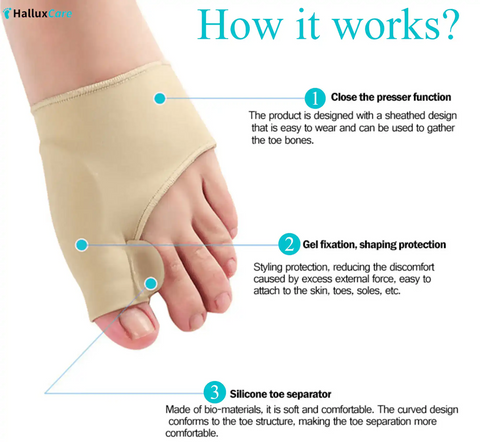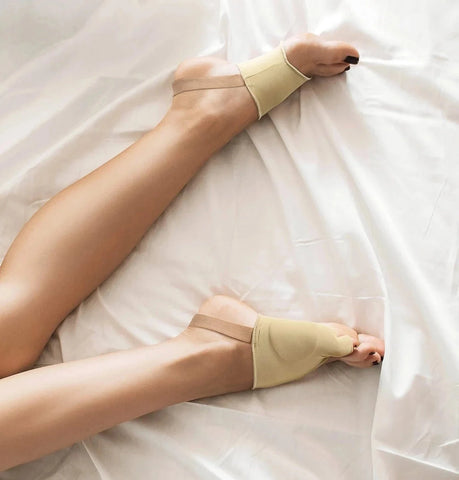Understanding Calf Pain and Its Link to Foot Health: Muscular Issues vs. DVT
Last updated: 2025-11-09T04:13:25.183Z
Author: Dr. Emily Harper, DPM, Board-Certified Podiatrist & Orthopedic Specialist
Key Takeaways
- Calf pain is frequently caused by muscular strain linked to foot deformities like bunions, not necessarily DVT.
- DVT presents with swelling, redness, warmth, and worsening pain; absence of these signs suggests muscular issues.
- Foot deformities alter biomechanics, increasing calf muscle strain and discomfort.
- Supportive footwear with a wide toe box and orthopedic bunion sleeves can alleviate calf pain.
- Regular stretching and monitoring symptoms help manage calf discomfort.
- Prompt medical evaluation is necessary if symptoms of DVT appear.
What Is a Bunion (Hallux Valgus) and Bunionette (Tailor’s Bunion)?
A bunion (hallux valgus) is a bony bump that forms at the base of the big toe, causing the toe to angle inward. A bunionette, or tailor’s bunion, occurs on the outside of the foot near the little toe. Both deformities affect foot alignment and can lead to altered walking patterns and muscle strain in the calf and lower leg [1][2].
Glossary:
- Bunion (hallux valgus): Prominent bump on the inside of the foot near the big toe.
- Bunionette (tailor’s bunion): Bump on the outside of the foot near the small toe.
- Toe spacers: Devices placed between toes to improve alignment.
- Bunion sleeves: Soft orthotic sleeves that cushion and realign the big toe.
- Orthoses: Custom or off-the-shelf devices to support foot structure.
Symptoms and When to Seek Care
Signs of DVT to Watch For [3]:
- Swelling in calf or foot
- Redness or discoloration
- Increasing or spreading pain
- Warmth over the area
- Difficulty walking or bearing weight
If these symptoms develop or worsen, seek immediate medical care.
Symptoms More Likely Muscular or Foot-Related:
- Pain linked to foot movement or shoe pressure
- Calf tightness without swelling or redness
- Pain that improves with rest or stretching
Conservative Management Options and Product Use Guidance
Managing calf pain related to foot problems focuses on improving foot alignment and reducing strain.
Orthopedic Bunion Sleeves
Medical-grade bunion sleeves realign the big toe, cushion irritated areas, and can improve walking posture, reducing calf muscle strain:
4.9 ⭐⭐⭐⭐⭐ ( 1843 reviews )
Benefits include:
- Toe realignment to reduce calf muscle overuse
- Protection from shoe friction and irritation
- Improved gait and balance, reducing leg fatigue [4]
Fit and Footwear Tips to Reduce Calf Pain
Proper footwear plays a crucial role in managing calf pain related to foot deformities:
- Wide toe box: Allows toes to spread naturally and reduces pressure on bunions.
- Supportive arch: Helps maintain proper foot alignment and reduces calf strain.
- Low to moderate heel height: Excessive heels increase forefoot pressure, exacerbating bunions and calf pain.
- Soft, breathable materials: Reduce irritation and improve comfort [5].
Exercises and Daily Routines to Strengthen Feet and Calves
Incorporate these simple routines to relieve and prevent calf pain:
- Calf stretches: Stand facing a wall, place hands on it, and step one foot back, keeping the heel down. Hold for 20-30 seconds.
- Toe stretches and curls: Use toe spacers or manually spread toes to improve flexibility.
- Foot rolling: Roll a tennis ball under the foot arch for 2-3 minutes to increase circulation.
- Strengthening exercises: Pick up marbles with toes or practice heel raises to strengthen calf muscles [6].
How to Use Orthopedic Bunion Sleeves: Simple Routine
- Wear sleeves during daily activities such as walking or standing to provide ongoing support.
- Pair with wide, comfortable shoes to enhance realignment and reduce pressure.
- Use consistently for best results, especially when symptoms flare.
- Combine with stretches and foot exercises to improve muscle balance.
Frequently Asked Questions (FAQs)
Are toe spacers safe for bunions?
Yes, toe spacers can help gently realign toes and relieve pressure. Use them gradually to avoid discomfort and always choose medical-grade options [7].
How long should I wear toe spacers daily?
Start with 15-30 minutes and increase as tolerated, up to a few hours daily. Avoid overnight use unless advised by a podiatrist.
Bunion vs tailor’s bunion – what’s the difference?
A bunion affects the big toe joint's inside edge, while a tailor’s bunion forms on the outside of the foot near the little toe.
Do bunion sleeves help with shoe comfort?
Yes, they cushion the bunion area, reduce friction, and improve toe alignment, making shoes more comfortable.
When should I see a podiatrist?
If pain persists despite conservative care, worsens, or if you notice swelling, redness, or warmth, consult a podiatrist promptly.
Can I run or play pickleball with a bunion?
With proper footwear and support, many can continue activity; however, pain or worsening symptoms should prompt medical advice.
Additional Resources
For more on foot health, bunion management, and footwear tips, explore our guides on toe spacers, bunion sleeves, and footwear fit.
Get Personalized Bunion Pain Guidance
If you're experiencing bunion pain, this free assessment tool can help you understand what might be causing your discomfort and what steps you can take today. The tool is powered by board-certified podiatrists and provides personalized guidance based on your specific situation.
Note: This tool provides educational guidance and is not a substitute for professional medical advice. If you're experiencing severe pain, persistent symptoms, or have concerns about your bunion, please consult with a podiatrist or healthcare provider.
References
- American Orthopaedic Foot & Ankle Society (AOFAS). “Bunions (Hallux Valgus).” https://www.aofas.org
- MedlinePlus. “Bunion.” https://medlineplus.gov/ency/article/001152.htm
- National Heart, Lung, and Blood Institute (NHLBI). “Deep Vein Thrombosis.” https://www.nhlbi.nih.gov/health-topics/deep-vein-thrombosis
- American Podiatric Medical Association (APMA). “Bunion Treatment.” https://www.apma.org/Patients/FootHealth.cfm?ItemNumber=981
- National Institute for Health and Care Excellence (NICE). “Footwear advice and bunion management.” https://www.nice.org.uk
- Journal of Orthopaedic & Sports Physical Therapy. “Effect of Foot Exercises on Muscle Strength.” https://www.jospt.org
- Cochrane Database of Systematic Reviews. “Non-surgical treatment for bunion.” https://www.cochranelibrary.com
What’s Your Experience?
Have you ever confused muscular calf pain with something more serious? How did foot health impact your leg pain? Share your stories or questions below — let’s learn from each other’s experiences!
```



